Novel appearances
DOI: 10.1063/PT.3.4044
Marcel Proust’s novel In Search of Lost Time, which was published in seven volumes between 1913 and 1927, contains 40 or so main characters and hundreds of minor characters. None of them is a physicist. What, if anything, are we to make of that vacuum?
Proust was familiar with science. His father, Achille Proust, was a prosperous pathologist and epidemiologist, who specialized in cholera and plague. Given the social circles that Marcel Proust frequented, the novelist could conceivably have met Louis de Broglie, who was awarded the 1929 Nobel Prize in Physics for wave–particle duality, and his older brother, Maurice, who was also a physicist. But according to Proust biographer Jean-Yves Tadié, Proust knew neither de Broglie brother. Proust was, however, good friends with another aristocratic scientist, Armand de Gramont, who did research in aerodynamics and founded a precision optics company.
Some of Proust’s most memorable characters are based on real people. Neurologist Jules Cotard, for example, was the model for the pompous yet talented physician Dr. Cottard. I speculate that Proust found no room for physicists in his 4200-page novel because either he didn’t know any or, if he did, he didn’t feel that a physicist’s presence would serve his novel’s plot.
Also devoid of physicists, despite their large casts and broad narrative sweeps through space, time, and society, are John Dos Passos’s trilogy U.S.A. (1930–36), Anthony Powell’s 12-volume sequence A Dance to the Music of Time (1951–75), and Simon Raven’s 10-volume sequence Alms for Oblivion (1964–76).
Then, as now, physicist remains a minority profession. Still, given the paucity of physicists in novels, it’s worth asking why the few novelists who have written about physicists made such a singular choice. It’s also worth asking what they made of their fictional physicists. This article addresses those two questions by looking at five varied works of fiction: Solar (2010) by Ian McEwan; The Absence of a Cello (1960) by Ira Wallach; Scenes from Provincial Life (1950) and its sequel, Scenes from Married Life (1961), by William Cooper; and The Dukays (1949) by Lajos Zilahy.

Extracting energy from the Sun is a plot element of Ian McEwan’s novel Solar. (Photo by Ashley Cooper pics/Alamy stock photo.)

The first question is easiest to answer for Solar. McEwan explained his choice in detail in a recorded interview before an audience. Cooper’s choice is also easily explained. Given that he was a physicist himself, his semiautobiographical novels were inevitably about a physicist. I resort to speculation for the third and fourth authors. Wallach seemed to choose a physicist for comic effect, whereas Zilahy seemed to choose a physicist, an astronomer in fact, because of what the profession represented: reason and modernity.
The second question, what the novelists made of their characters, is an important one. Whether we like it or not, books, movies, and TV shows that include physicists influence the public’s perception of us, for good and for bad. (See Margaret Weitekamp’s article “The image of scientists in The Big Bang Theory,” Physics Today, January 2017, page 40
Physicist as boor
Climate change and what to do about it provide Solar’s scientific setting. McEwan was inspired to tackle the topic following an all-expenses-paid trip that he and other writers and artists made in 2005 to the Norwegian Arctic island of Spitsbergen. Their host was Cape Farewell, a nonprofit organization that seeks a cultural response to climate change.
Although physicists are engaged in understanding climate change and in developing ways to mitigate its effects, they are joined in those efforts by atmospheric chemists, economists, meteorologists, materials engineers, oceanographers, and other scientists. Of all those vocations that his main character, Michael Beard, could follow, McEwan opted for physicist. As he recounted in a 2012 interview at the Newcastle Centre for the Literary Arts, he made his choice after attending a climate change summit that German chancellor Angela Merkel convened in Potsdam in 2007.
The first thing McEwan noted about the conference—its “gimmick” as he put it—was the speaker list. All were Nobel Prize recipients, and, almost inevitably, all were men of a certain age. Their award-winning work, he speculated, was in the past. Nevertheless, they controlled big budgets, ran big institutions, and operated where science and government meet. McEwan likened the concentration of scientific power to a watering hole in Botswana, where the laureates were the big beasts.
That spectacle prompted McEwan to conceive of a main character who, having been awarded the Nobel Prize in Physics for work he had done 20–30 years ago, was now just coasting. Climate change would provide the novel’s backdrop. To connect it to his fictional physicist, McEwan blithely decided that the prize had been given for “modifying Einstein’s photovoltaics.” After further thought, McEwan sought the advice of theoretical biologist Graeme Mitchison, who elaborated on what the physicist, Beard, had done.
The photoelectric effect, which Einstein explained in 1905 as a quantum phenomenon, entails photons kicking out electrons from the surface of a metal. The photovoltaic effect entails photons kicking up electrons into an excited state in the surface of a semiconductor. Although the two phenomena share similarities, McEwan might be stretching things a bit to have his fictional physicist tie them together in a quantum field theoretic framework, the “Beard–Einstein conflation” of the novel.
That stretch aside, the Beard–Einstein conflation is plausibly invoked in the novel to describe quantum coherence in photosynthesis. The conflation is also, plausibly, the theoretical basis of a new and efficient way to catalytically split water with solar energy, hence the novel’s title.
Given that Beard’s life, past and present, occupies so much of the novel, how convincing a physicist is he? Before addressing that question, I should point out that most of the plot’s action takes place after Beard has all but retired from doing research. McEwan is free therefore to explore his main character’s other qualities, which are mostly loathsome.
Besides being lazy, Beard is duplicitous, venal, gluttonous, and philandering. At best he’s pitiable; at worst, despicable. If the novel weren’t satirical and funny, reading about Beard, his thoughts, and his deeds would be trying.
But McEwan does manage to weave in observations and plot elements that are consistent with Beard’s profession. For example, while an undergraduate at Oxford University, Beard bones up on the 17th-century poet John Milton to woo and bed Maisie, a student of English literature. Smugly, the young Beard observes that while he could pass as a literature maven after a month’s study, humanities students could never pass as physicists, no matter how hard they tried.
Physicist as source of humor
I’d deliberately sought Solar, having read favorable critiques of it. Serendipity led me to the next book under discussion here. In May 2013, while browsing in a used bookshop in the English town of Tewkesbury, I spotted a paperback novel whose worn spine bore the intriguing title The Absence of a Cello. Thinking that the book might be about my favorite musical genre, the string quartet, I pulled it from the shelf. To my surprise, it turned out to be about a particle physicist. The Penguin edition’s blurb begins, “Andrew Pilgrim, gifted physicist, needs work. A slight attack of bankruptcy mars his curriculum vitae: otherwise, on paper, he’s just the man the Baldwin-Nelson Corporation are looking for.”
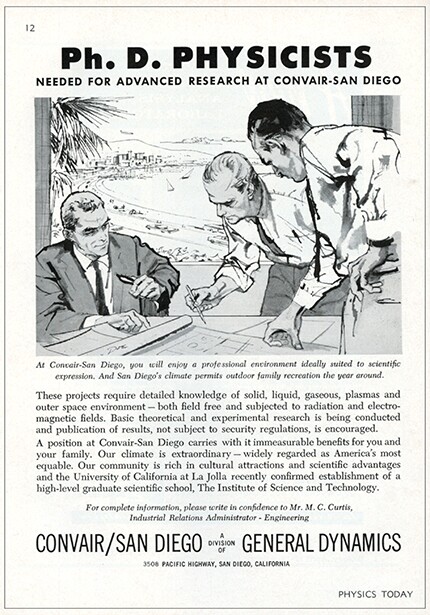
Faced with bankruptcy, the main character of Ira Wallach’s novel The Absence of a Cello contemplates becoming an industrial physicist. This ad appeared in Physics Today’s April 1959
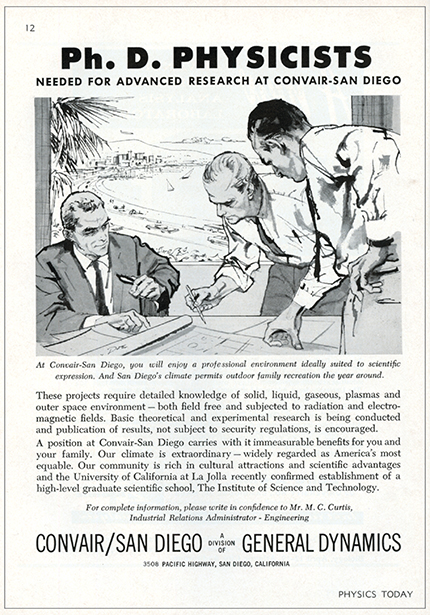
I bought the book, which was first published in the US in 1960. Its author, Ira Wallach, was born in New York City in 1913. Although only one of Wallach’s books remains in print, he appears to have led a successful literary life as a novelist, screenwriter, and dramatist (Wallach died in 1995). His 1959 comic novel about the cult of bodybuilding in Southern California, Muscle Beach, became the 1967 film Don’t Make Waves, starring Tony Curtis and Claudia Cardinale.
The action of The Absence of a Cello takes place in Manhattan—mostly in the Central Park West apartment that the main character, Andrew Pilgrim, shares with his wife, Celia, and their college-age daughter, Joanna. Pilgrim could once afford such expensive lodgings and a 1931 Rolls-Royce because he and a fellow physicist, Peter Knowles, had set up a company that undertook research for corporate and government clients.
The bankruptcy mentioned in the blurb arose because Pilgrim and his business partner neglected their clients and preferred instead to work on their own research projects (parity violation in weak interactions in Pilgrim’s case; orbital mechanics of Jupiter’s moons in Knowles’s case).
As if to compound Pilgrim’s misery, just as he is about to submit his magnum opus on P symmetry violation, he’s scooped by “two young Chinese physicists.” Wallach doesn’t name them, but he surely meant Tsung-Dao Lee and Chen Ning Yang, who demonstrated in 1956 that P symmetry violation was not only possible in weak interactions but also detectable. Lee and Yang shared the 1957 Nobel Prize in Physics for their discovery.
When the plot begins, Pilgrim faces financial ruin. His one lifeline is the possibility of an R&D job at Baldwin-Nelson, a large company headquartered in Chicago that produces refrigerators and other consumer goods. Despite his undoubted talent, Pilgrim is not a shoo-in for the position. To prevail, he must win over the company’s sanctimonious and inquisitorial personnel chief, Otis Clifton, who insists on evaluating Pilgrim at his home.
The source of the novel’s dramatic tension lies in whether Pilgrim will get the job. Coaching him in the ways of corporate America is Joanna’s fiancé, Perry Blewitt, who attends the Wharton School of Business. Blewitt warns Pilgrim not to underestimate Clifton: “You don’t know what you’re up against, Mr. Pilgrim. Baldwin-Nelson is interested in one major factor: your attitudes, your temperament. They pick at you like a turkey carcass. They try to determine things like your extroversion rating.”
The novel’s humor comes, in part, from the conflict between Pilgrim’s abstract, sometimes naive view of the world and Clifton’s psychologically sophisticated, materialist one. Pilgrim himself is conflicted. He wants to pursue pure research while at the same time enjoying the fruits of a salary that only corporate America could provide. A mathematician would have offered a sharper, perhaps funnier contrast between the academic and the corporate. But given that three Bell Labs physicists had shared the 1956 Nobel Prize in Physics for inventing the transistor, a physicist would be the more plausibly employed in industry.
The novel’s humor also comes from Wallach’s wry observations of his characters’ motivations and the witty lines he has them speak. One of my favorite scenes occurs when Pilgrim’s sister, a young widowed chemist named Marian Jellicoe, buys perfume at a department store in preparation for seducing Clifton. In answer to the salesman’s question about what kind of perfume she has in mind, she replies, “Imagine that I was locked in a cage in the Rocky Mountains, a hundred miles from the nearest habitation. I spray a little perfume on myself. Within two hours, hundreds of men converge on the cage. They are torn and bleeding because they have fought their way through brambles and briers, waded swamps, and forded rivers. That’s the perfume I want.”
As the plot unfolds, it becomes clear that Pilgrim is unsuited to a career at Baldwin-Nelson. But thanks to scheming by Marian and his neighbors, the Littlewoods, Clifton reluctantly offers Pilgrim the job. Pilgrim declines it and takes a position at MIT instead. His financial ruin is averted because Clifton, who has formed a romantic attachment to Marian, offers Pilgrim a lucrative position as a consultant.
As I read the book, I drew on AMC’s TV series Mad Men to help picture what the characters and the New York City locations looked like. Midcentury Manhattan might seem distant, but Clifton’s psychological tests are not unlike the ones that Google subjects its interviewees to. And soon after I finished the book in 2014, Science magazine’s Careers department published an article that Clifton would endorse, “Scrutinizing your personality,” part of a series on the psychology of interviews.
What also hasn’t changed since the book’s publication is the difference between being an academic physicist and an industrial physicist. I have never worked in industry, but I got a taste of its characteristic rewards—and frustrations—when I edited John Waymouth’s engaging article, “Physics for profit and fun,” which appeared in Physics Today’s February 2001
I spent my entire working life using physics to grub for paydirt in an industrial setting. By this I do not mean the central research laboratory of a multibillion-dollar technological conglomerate able to support “pure” curiosity-driven study. I mean the product development laboratory of a nose-to-the-grindstone division engaged in a battle for market share in a rather prosaic industry that nevertheless depended on mastery of some complex and challenging technology. In such a setting, any project that yielded only meeting presentations or publications in refereed journals had to be considered essentially a failure.
I’m not sure if I was ever cut out for work in industry. But in retrospect, I wish I had read Waymouth’s article or something like it when I was an undergraduate. Then, I gladly chose to pursue a career in academic research. But because of my ignorance, I cannot say that I expressly rejected a career in industry.
How Wallach came to know the ways of physicists remains a mystery to me. His New York Times obituary offered no hint that he knew or had encountered any physicists. I can say, however, that my initial hunch about the title of his novel was correct. In the book, Pilgrim plays cello in an amateur string quartet. If he took the Baldwin-Nelson job, the quartet would have a vacancy to fill.
Physicist as bureaucrat
McEwan (born 1948) is an award-winning novelist, whose books, Atonement (2001) among them, have been made into movies. William Cooper (1910–2002; real name Harry Hoff) is much less known than McEwan, even in his native UK. Born in the northern English town of Crewe, Cooper studied physics at Cambridge University, where his academic adviser was physicist, novelist, and bureaucrat C. P. Snow.
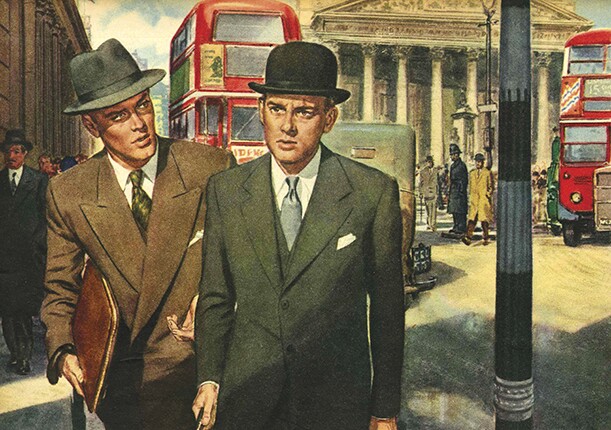
The two main characters of William Cooper’s novel Scenes from Married Life are government scientists in 1950s London.
THE ADVERTISING ARCHIVES/ALAMY STOCK PHOTO
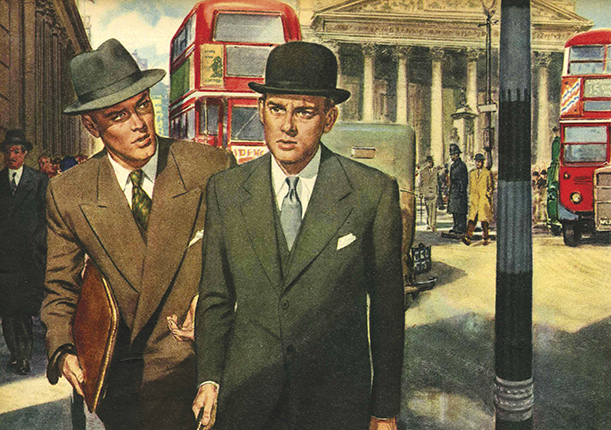
Cooper’s first job after earning his bachelor’s degree was as a physics teacher at a high school in Leicester, a modestly sized city in England’s East Midlands. His novel Scenes from Provincial Life is set in a nameless, Leicester-like place just before World War II. It follows the life of Joe Lunn, a physics teacher who aspires to be a successful novelist, just as Cooper did at that time.
Scenes from Provincial Life was Cooper’s fifth novel. In retrospect, it was the first of several British novels whose protagonists’ ordinary lives illuminated with wry humor the smug, dreary conventions of midcentury Britain. John Wain’s Hurry on Down (1953), Kingsley Amis’s Lucky Jim (1954), and Keith Waterhouse’s Billy Liar (1959) were among the novel’s descendants.
Cooper’s novel attracted me not just because of its literary significance. I was also intrigued to see if his background as a physicist was manifest in the novel’s characters, plot, or themes. It wasn’t. Besides one brief episode in which Lunn tells his senior class to look for Newton’s rings, little of physics or physicists makes an appearance. Lunn, perhaps like Cooper himself, was more preoccupied with becoming a novelist and pursuing his sex life than physics.
The edition I bought pairs Scenes from Provincial Life with Scenes from Married Life. Set in London in 1950 and published in 1961, the novel continues to follow Lunn, who has progressed from aspiring novelist to published novelist. His books don’t sell well enough to sustain him full-time, so he, as Cooper himself did, works as a civil servant tasked with ensuring that Britain’s research enterprise has the scientific staff it needs to flourish.
Cooper’s mentor, Snow, appears in the novel as Lunn’s boss, Robert (we never learn his surname). Together, the two physicists engage in office politics and pursue their respective literary careers. They also each meet and marry teachers.
As in the earlier novel, physics remains in the background. But there are at least two episodes in which Cooper’s inner physicist speaks out. The first is rather brief. Shopping for rings with Robert, Lunn is shocked to discover that wedding rings are much cheaper than engagement rings. “I had no idea that wedding rings were to be had for units of pounds,” he writes, as any physicist might. Indeed, I had the same reaction 24 years ago when my wife and I bought our wedding rings.
The second episode is longer and launches one of the novel’s subplots. Lunn is assigned to interview organic chemists for temporary jobs at one of Britain’s explosives research establishments. Evidently, Lunn (and presumably his creator, too) held a low opinion of organic chemists, as you can tell from the following extract:
Organic chemists had come to be my bêtes noires—they seemed to me to be characterised by a peculiar combination of narrowness and complacency, having changed neither their techniques nor their opinion of themselves since the days of World War I. Organic chemistry had seen some truly glorious days at the beginning of the century, and the 1914–18 war, with everybody thinking mostly about explosives and poison gas, had been a chemists’ war. But after that had come the glorious days of atomic physics; and World War II, with everybody thinking mostly about first radar and then atomic bombs, was a physicists’ war. To the sort of young men I had to see the point had not gone home. On they went, sticking together parts of molecules, by their crossword-puzzley techniques, to make big molecules: then, by more crossword-puzzley techniques, they verified that they had made what they thought they had made: and then started all over again.
When asked if they used techniques nowadays invented and used by physicists, they said to me rebukefully:
“I rely on classical methods.”
And when invited to discuss the way their parts of molecules behaved in terms of electronic structure, they said very rebukefully indeed:
“I’m afraid I’m not a theoretician.”
Some of them, it seemed to me when I got particularly desperate, might never have heard the electron had been discovered.
(In fairness I have to say that since then—I am writing about 1951 and it is now 1960—my opinion has changed. Young organic chemists have changed, to the extent of whipping at least one “modern technique,” nuclear magnetic resonance, smartly out of the hands of physicists.)
Parenthetical admission aside, the typical—even stereotypical—haughtiness of physicists with regard to the practitioners of other sciences shines out from the extract. In the novel, Lunn’s attitude to one organic chemist in particular leads to an incident that almost ends his civil service career. I won’t say more, lest you want to read the novel for yourself.
As for Cooper, managing scientific workforces became his specialty. He worked at the UK Atomic Energy Authority to stem Britain’s brain drain and served as a personnel consultant to the European Commission. Like Lunn, he continued to publish books, although only Scenes from Provincial Life and Scenes from Married Life remain in print.
Physicist as exemplar of reason and progress
The Dukays is the 795-page magnum opus of the Hungarian novelist and playwright Lajos Zilahy. Written in 1949, the novel tells the story of Count István Dukay, his family, and his times. It begins in the late 1800s when Hungary, as Austria’s partner in the Hapsburg Empire, ruled an area the size of modern Germany. Most of the action, however, takes place in the two decades after World War I, a conflict that led to the dissolution of the empire and, with it, the dismemberment of Hungary’s imperial possessions.
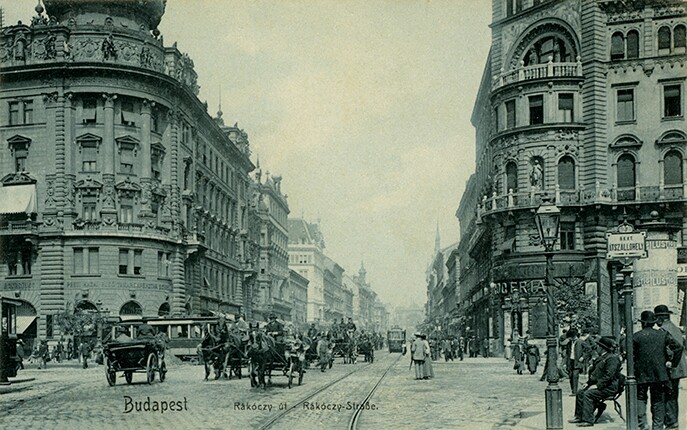
Fin de siècle Budapest is one of the settings of Lajos Zilahy’s novel The Dukays.
LEBRECHT MUSIC & ARTS/ALAMY STOCK PHOTO
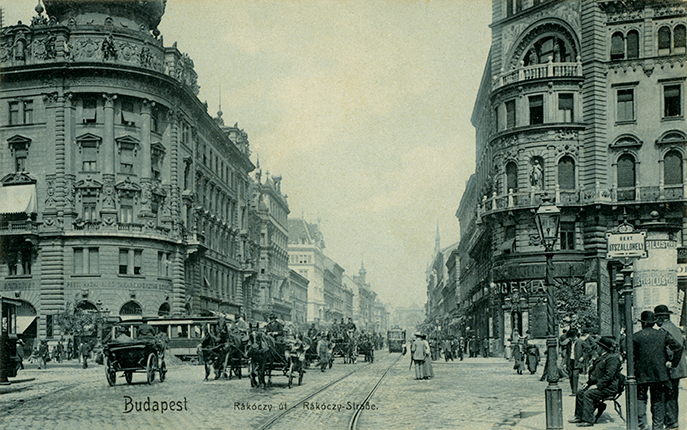
Dukay’s vast estates in the Great Hungarian Plain remain intact when the novel ends in 1939, but their continued existence is threatened by the land-reform movement in the person of Mihály Ursi, who first appears on page 624. At that point, the plot is following Dukay’s youngest daughter, Zia, as she recovers from a failed marriage to an Italian prince. She’s living frugally on the fictional Adriatic island of Mandria (based, I think, on Susak, Croatia), where she practices her hobby of photography. Ursi asks her to take his photograph after accidentally dropping his passport into the sea.
To my surprise, soon after the photography session is over, readers learn that Ursi is an astrophysicist. Biographical information in English about Zilahy is hard to find, so I’m not sure whether the novelist was friends with any astrophysicists. Still, it’s at least conceivable that he might have encountered his physicist contemporaries and compatriots Leo Szilard, Edward Teller, and Eugene Wigner in Budapest. He did know Albert Szent-György, the discoverer of vitamin C and pioneer in the application of electron microscopy to biology.
Ursi’s profession serves the novel in two ways. First, the calm, rational astrophysicist provides a sharp contrast to both Filippo Ozzolini, Zia’s foppish, philandering husband, and Dukay, her rich, aristocratic father—as the following small details illustrate: Whereas Ozzolini smokes cigarettes in a diamond-encrusted ebony holder and Dukay keeps his cigars in a suitcase-sized humidor, Ursi doesn’t smoke at all.
Second, by choosing to make his land-reform advocate an astrophysicist, Zilahy suggests that land reform is a rational, even scientific, policy. Indeed, one of the book’s highlights is the verbatim introduction to Ursi’s eloquent polemic, The Great Fallow. In the following extract, Ursi begins to justify his interest in land reform as an inevitable consequence of his astronomical research:
When he lays down his complicated instruments, bolometers, actinometers, pyrheliometers, photometers, his prismatic grated spectroscopes, knowing that the hundred billion stars of the Milky Way represent but an infinitesimal fraction of the cosmos, the astronomer—when he says farewell to his laboratory, to the clouds of Magellan Major and Magellan Minor, to the constellation of Andromeda, to the clusters of spheres hurtling through space a distance of hundreds and hundreds of millions of light years; when he sits down to supper with the evening paper in hand—the astronomer cannot help himself if his eyes, his brain, and his whole frame of reference regard the tax bill submitted by the Finance Minister, the burglary-cum-murder on Dob Street, regard even the price of kale in the column of market prices from the viewpoint of the universe as a whole.
Literary fiction hardly abounds with astronomers—which is to say I’m struggling to recall any astronomer characters in the books I’ve read. That paucity could constitute a missed opportunity. Although Ursi focuses his cosmic view on land reform and the condition of the Hungarian peasantry, other fictional astronomers could bring their minds to bear on other problems.
Real life has provided novelists with at least one model, astrophysicist and democracy activist Fang Lizhi, whose obituary appeared on page 66
What general conclusions, if any, can be drawn from the fictional physicists discussed here? None of them conform to the stereotypes of mad scientist, absent-minded professor, or hyper-rational observer that Margaret Weitekamp mentions in her feature article about The Big Bang Theory. That nonconformity, I think, is comforting. If the characters created by McEwan, Wallach, Cooper, and Zilahy deviated too far either from real physicists or from what readers consider as real physicists, their novels would be less convincing.
I thank Melinda Baldwin, Ashley Smart, and Spencer Weart for helpful comments on the first version of this essay.
More about the Authors
Charles Day is Physics Today’s editor-in-chief. This article grew out of posts that appeared on his blog, The Dayside, in 2010–15.

